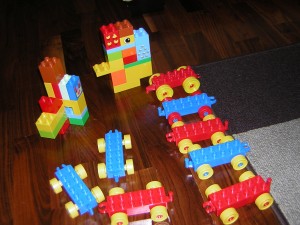Lego is a fun toy for all kinds of play that supports young children’s early learning and kindergarten readiness. Blocks can be used for making different patterns or a repetitive sequence. Patterning is an important thinking skill.
S Sometimes, when we have to remember a large amount of information, we use the strategy of noticing a pattern. Suddenly, the amount of information we need to hold in our memory is much, much smaller. The pattern makes the job easier. Being able to notice, figure out and make patterns is a powerful strategy for brains. Think of crawling and walking. That’s a left-right, left-right pattern. Language, music, and math are also patterns.
Sometimes, when we have to remember a large amount of information, we use the strategy of noticing a pattern. Suddenly, the amount of information we need to hold in our memory is much, much smaller. The pattern makes the job easier. Being able to notice, figure out and make patterns is a powerful strategy for brains. Think of crawling and walking. That’s a left-right, left-right pattern. Language, music, and math are also patterns.
When Little Sister was playing with her Duplo blocks, I lined up a few cars in a simple pattern: red-blue, red-blue. As I pointed to each car, I also said the color. I spoke to the train cars and told the blocks they were making a pattern, first red then blue, then red and blue again. Then, I asked Little Sister what color would come next and together we figured out a red one. She was able to say a blue car would come after that but changed the play to putting blocks on the cars. Perhaps, another day we’ll make a tower in a pattern or maybe a road.
Some children may catch the idea and some may need lots more fun with patterns before they understand. for instance, when dressing your child you may suddenly notice that a shirt has a pattern, “Look at that, your t-shirt has lines in a pattern. It goes blue-yellow, blue-yellow all over.” Or a cereal bowl may have a pattern. Maybe snack time will have a pattern, slice of banana and then a grape, slice of banana and then a grape. Usually in a day patterns will pop up frequently. Music, books, singing, talking, rhymes, and of course playing will all help build patterning abilities.
Just a few seconds here and there will add up to helping build patterning and memory. What patterns can you and your child find or make today?
